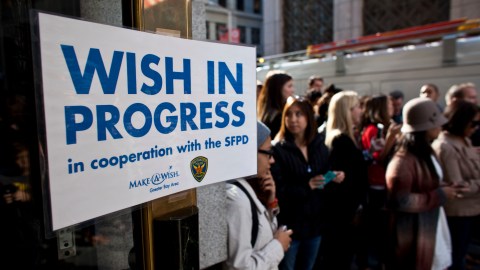Is granting children’s wishes cost-effective? A new study looks at Make-A-Wish.

Ramin Talaie/Getty Images
- Make-A-Wish stories are heartwarming, but are they worth the cost?
- Effective donations to the right charities can save lives, even if they don’t make for good reading.
- A recent study into the value of wishes on health care costs gives good news for everybody.
Remember Batkid? That adorable little cancer patient who saved San Francis— I mean, Gotham, from the Riddler and Penguin? Who had a whole article about him in the San Francisco Chronicle written by Clark Kent? Who reminded us that the world isn’t all that bad?
His story is one of the more notable wishes granted by the famous Make-A-Wish Foundation; which turns charity donations into fantastic experiences for children with serious illnesses.
However, the question of if it is a worthy charity has been asked by no less a person than the philosopher and champion of effective altruism Professor Peter Singer. In his 2013 Washington Post op-ed, published in response to the Batkid event, he argues that Make-A-Wish is nice, but that the money really doesn’t accomplish much and that we would do better to donate the money to other charities.
Effective Altruism is the downer who gets things done
While it might seem that only the most miserly or calloused individual could object to what Make-A-Wish does, Singer brings up an important point: our charity dollars can also save countless lives. As a utilitarian philosopher, Singer has argued that we have an obligation to donate what we can to help others — and he puts his money where his mouth his. He’s the founder of the nonprofit The Life You Can Save, which helps fight extreme poverty and its effects.
How we invest our donations is a vital question that costs lives when it is answered incorrectly. As he puts it in his Op-ed:
“The average cost of realizing the wish of a child with a life-threatening illness is $7,500. That sum, if donated to the Against Malaria Foundation and used to provide bed nets to families in malaria-prone regions, could save the lives of at least two or three children (and that’s a conservative estimate). If donated to the Fistula Foundation, it could pay for surgeries for approximately 17 young mothers who, without that assistance, will be unable to prevent their bodily wastes from leaking through their vaginas and hence are likely to be outcasts for the rest of their lives. If donated to the Seva Foundation to treat trachoma and other common causes of blindness in developing countries, it could protect 100 children from losing their sight as they grow older.”
The cost has gone up since Singer’s article and is now $10,130. So, the question is even more pressing.
So, is Make A Wish worth the cost?
As it happens, a study diving into that very question was published in Pediatric Research in October of 2018. Four hundred and ninety-six patients who got their wishes granted were compared to 496 “control” patients who weren’t involved with the program. The two groups had similar age and gender demographics and all the patients had similar diseases. The researchers followed the patients for two years and measured the “hospital utilization,” in this case defined as “visits to primary, urgent, emergent care, and planned/unplanned inpatient hospitalizations,” of every patient.
The results were surprisingly good. Patients who received wishes used fewer hospital services than those who did not. The savings as a result of this were determined to be higher than the cost of a wish, making the program cost-effective.
Now, the study isn’t without issues. For starters, it isn’t randomized. Secondly, it doesn’t directly approach the question of hospital admissions but rather plays around with a binary variable of “has fewer admissions” and “does not have fewer admissions” and then works from there. Similarly, the study doesn’t directly estimate if the total cost of wishes is more or less than the expected savings.
Speaking to Vox, Professor Andrew Gelman of Columbia University took issue with some of the researchers’ methods and explained, “The practice of discretizing variables is common in medical statistics, and I think it’s generally a bad idea.”
Lastly, while it demonstrates that the events are good for more than just fun outings and feel-good news stories, this study does not answer the question posed by Peter Singer and others on if we should donate to Make-A-Wish before some other charity, though it does provide data for use in the discussion.
There you have it, wishes work. While the question of if the effectiveness of the wishes outweighs the value of donating to a charity that will directly save lives at a much lower cost remains to be settled, we can know that the heartwarming stories of ill children having a day of unrivaled fun aren’t without medical benefit.





